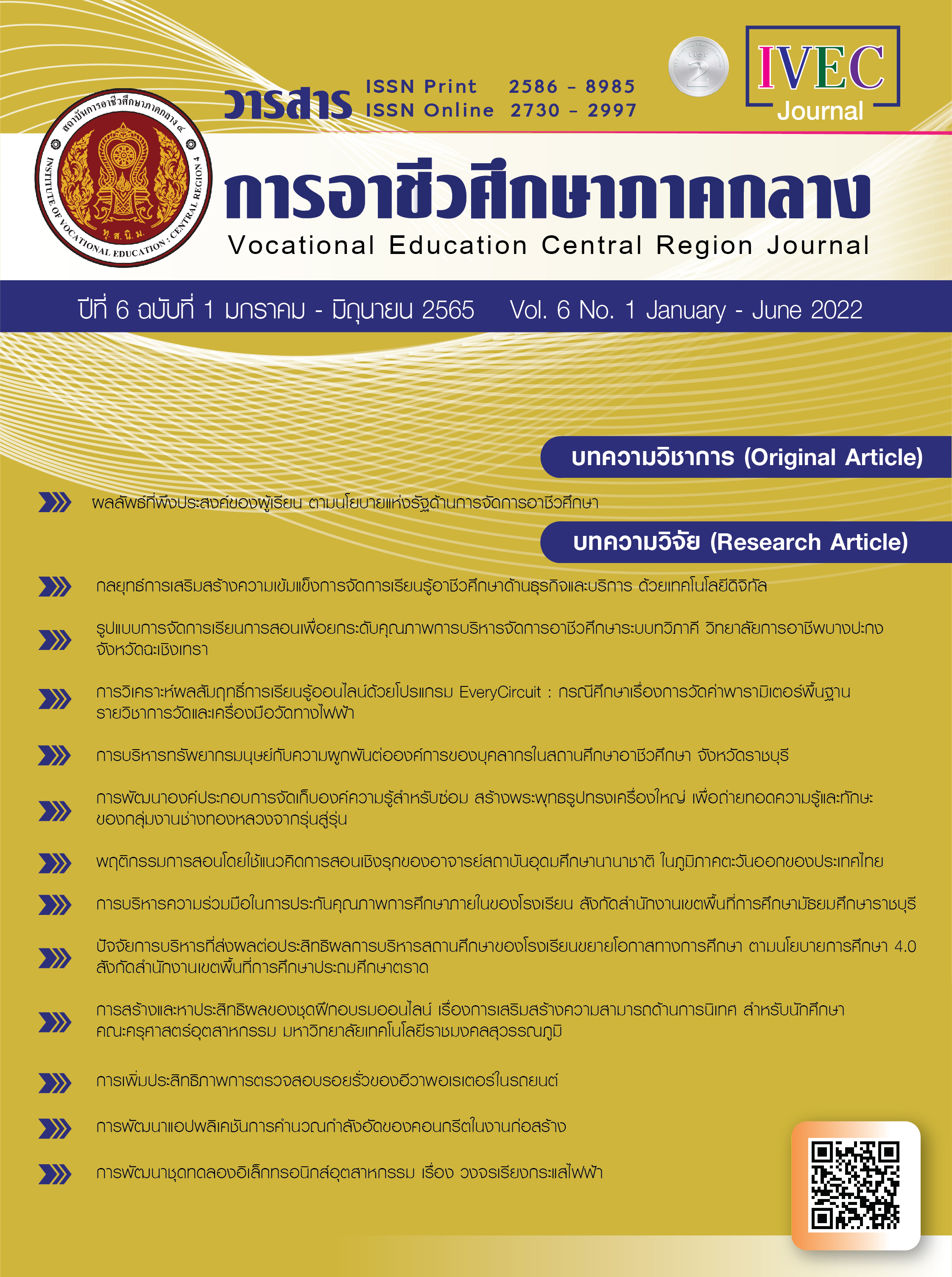Learning and Instruction Model for Enhance Quality Administration Dual Vocational Education of Bangpakong Industrial and Community Education College Chachoengsao Province
Main Article Content
Abstract
The purpose of this research was 1) to study the condition of Administration Dual Vocational Education of Bangpakong Industrial and Community Education College 2) to create Learning and Instruction Model 3) to apply the guidance of Learning0and instruction Model for implementation 4) to assess the appropriate and possible of Learning and Instruction Model. The population consisted of Administrator, teachers and trainers, experts for Focus group and evaluated suitability and flexibility. Tools consist of the questionnaire, the recording form of the focus group, reporting the achievement, the analysis of the information by percentage, average, Standard Deviation, and the analysis of the content.
The results of the evaluation revealed that:
1. Condition of Administration Dual Vocational Education of Bangpakong Industrial and Community Education College was the moderate level.
2. To create Learning and Instruction Model have 5 aspects, evaluation suitability and flexibility of model were at the highest level.
3. Result of model to practice satisfied and the results of knowledge and learning at the highest level.
4. To assess of Learning and Instruction Model 4.1) The Quality students in Standard of Dual Vocational Education in 3 competencies overall were at the highest level. 4.2) The opinions of administrators, teachers and trainers of Model in overall were at the highest level.4.3) The satisfaction of trainers in overall were at highest level. 4.4) The success of students was 90.91% in company and 9.09 at study graduate program.
Article Details

This work is licensed under a Creative Commons Attribution-NonCommercial-NoDerivatives 4.0 International License.
|
บทความ ข้อมูล เนื้อหา รูปภาพ ฯลฯ ที่ได้รับการตีพิมพ์ในวารสาร การอาชีวศึกษาภาคกลาง ถือเป็นลิขสิทธิ์ของวารสารการอาชีวศึกษาภาคกลางหากบุคคลหรือหน่วยงานใดต้องการนำทั้งหมดหรือส่วนใดส่วนหนึ่ง ไปเผยแพร่ต่อหรือเพื่อกระทำการใด ๆ กองบรรณาธิการไม่สงวนสิทธิ์ ในการคัดลอกบทความเพื่อการศึกษาแต่ให้อ้างอิงแหล่งที่มาให้ครบถ้วน สมบูรณ์ สงวนสิทธิ์ โดย สถาบันการอาชีวศึกษาภาคกลาง 4 ที่ตั้ง 90 ถนนเทศา ตำบลพระปฐมเจดีย์ อำเภอเมือง จังหวัดนครปฐม โทรศัพท์ 034 242 856 , โทรสาร 034 242 858 ISSN : 3056-9176 (print) ISSN : 2985-2382 (online) |
References
ชาญชัย อาจินสมาจาร. (2557). จิตวิทยาอุตสาหกรรมและองค์การ (พิมพ์ครั้งที่ 1). ปัตตานี: สถาบันเพื่อความก้าวหน้าทางวิชาการ.
ณัฐวิทย์ มุงเมือง. (2560, มกราคม- มิถุนายน). การพัฒนา ความร่วมมือการจัดการอาชีวศึกษาระบบทวิภาคีของ วิทยาลัยการอาชีพในภาคเหนือตอนบน. พิฆเนศวร์สาร, 13 (1), หน้า 133 -146.
ธานินทร์ ศรีชมพู. (2557, กรกฎาคม-กันยายน). การพัฒนารูปแบบการบริหารงานอาชีวศึกษาระบบทวิภาคีในสถานศึกษา สังกัดคณะกรรมการการอาชีวศึกษา. วารสารศึกษาศาสตร์ มหาวิทยาลัยนเรศวร, 16(3), หน้า 120 - 131.
นิรุตต์ บุตรแสนลี (2561). การพัฒนารูปแบบการจัดการอาชีวศึกษาระบบทวิภาคีที่มุ่งเน้นประสิทธิผลของสถานศึกษา สังกัดสำนักงานคณะกรรมการการอาชีวศึกษาด้วยกระบวนการวิจัยเชิงปฏิบัติการแบบมีส่วนร่วม. วิทยานิพนธ์ปรัชญาดุษฎีบัณฑิต สาขาวิชาวิจัยวัดผลและสถิติการศึกษา มหาวิทยาลัยบูรพา.
เบญจวรรณ ศรีคำนวล. (2560, พฤษภาคม–สิงหาคม). ปัจจัยที่ส่งผลต่อความสำเร็จในการจัดการอาชีวศึกษาระบบทวิภาคีของสถานศึกษาในจังหวัดลำปาง สังกัดสำนักงานคณะกรรมการการอาชีวศึกษา. วารสาร Veridian E-Journal,Silpakorn University, 10(2), ฉบับภาษาไทยมนุษยศาสตร์ สังคมศาสตร์ และ ศิลปะ, หน้า 2535–2548.
ประกาศคณะกรรมการการอาชีวศึกษา เรื่อง มาตรฐานการจัดการอาชีวศึกษาระบบทวิภาคี พ.ศ. 2563. (2563, 20 สิงหาคม). ราชกิจจานุเบกษา (เล่ม 137 ตอนพิเศษ 191 ง, น. 29- 33).
เพชรโยธิน ราษฎร์เจริญ. (2564, กรกฎาคม – กันยายน). กลยุทธ์การบริหารจัดการอาชีวศึกษาระบบทวิภาคีแบบมีส่วนร่วมเพื่อพัฒนาคุณภาพผู้เรียน ตามกรอบคุณวุฒิอาชีวศึกษา วิทยาลัยเทคนิค ธัญบุรี. e-Journal of Education Studies, Burapha University, 3(3), หน้า 19-37.
ยุพาวดี ศิริปีริดิ์. (2557). การจัดการอาชีวศึกษาระบบทวิภาคีในสถานศึกษาสังกัดอาชีวศึกษาจังหวัดอุดรธานี. วิทยานิพนธ์ ปริญญาศึกษาศาสตรมหาบัณฑิต สาขาวิชาบริหารการศึกษา วิทยาลัยสันพล.
ศิริขวัญ ยิ่งเจริญ. (2553). สภาพและปัญหาในการดำเนินการประกันคุณภาพการศึกษามหาวิทยาลัยราชภัฏราชนครินทร์. วิทยานิพนธ์ ปริญญาศึกษาศาสตรมหาบัณฑิต สาขาวิชาวิจัยและประเมินผลการศึกษา บัณฑิตวิทยาลัย มหาวิทยาลัยเกษตรศาสตร์.
สำนักงานคณะกรรมการการอาชีวศึกษา. (2557). แนวทางปฏิบัติการจัดการอาชีวศึกษาระบบทวิภาคี ตามประกาศกระทรวงศึกษาธิการ เรื่องมาตรฐานการจัดการอาชีวศึกษาระบบทวิภาคี พ.ศ.2557. กรุงเทพฯ: จามจุรีโปรดักส์.
สุเมธ รินทลึก และ วิชิต แสงสว่าง. (2564, กรกฎาคม–กันยายน). การจัดการอาชีวศึกษาระบบทวิภาคีสู่ความเป็นเลิศในสถานศึกษา สังกัดอาชีวศึกษาจังหวัดฉะเชิงเทรา. วารสาร มจร สังคมศาสตร์ปริทรรศน์, 10(3), หน้า 39-53.
สุรชัย ลาพิมพ์. (2562, มกราคม-มีนาคม). การพัฒนาแนวทางการจัดการศึกษาระบบทวิภาคีสู่ความ เป็นเลิศของวิทยาลัยสังกัดอาชีวศึกษาจังหวัด อุดรธานี. วารสารการบริหารการศึกษาและภาวะผู้นำ มหาวิทยาลัยราชภัฏสกลนคร, 8(30), หน้า 137-147.
อุดมศักดิ์ มีสุข. (2560, กันยายน - ธันวาคม). การพัฒนารูปแบบการจัดการ อาชีวศึกษาระบบทวิภาคี สาขาช่างอุตสาหกรรมในสถานศึกษาสังกัดสถาบันการอาชีวศึกษาภาคกลาง. วารสาร วิทยาลัยดุสิตธานี, 11(3), หน้า 221- 235.
Deming, W. E. (1986). Out of the Crisis. Cambridge: MIT, Center for Advanced Engineering study.
Hofmann, C. (2014). Support form teachers and trainers in Vocational education and training : The pathways to career aspirations and further career development. International Journal for Research in Vocational Education and Training, 1,(1), p. 1-20.
Minghat, A. D., & Yasin, R. M. (2010). A sustainable framework for technical and vocational education in Malaysia. Procedia Social and Behavioral Sciences, 9, pp. 1233-1237.
Parker, E. L. (2008). Factors that contribute to a successful secondary vocational education program in the state of Mississippi. (Doctoral Dissertation). The University of Southern Mississippi: Oxford, Mississippi.
Singh, M. (2005). School Enterprise: Combining Vocational Learning with Production. Berlin: United Nations Educational, Scientific, and Cultural Organization.


